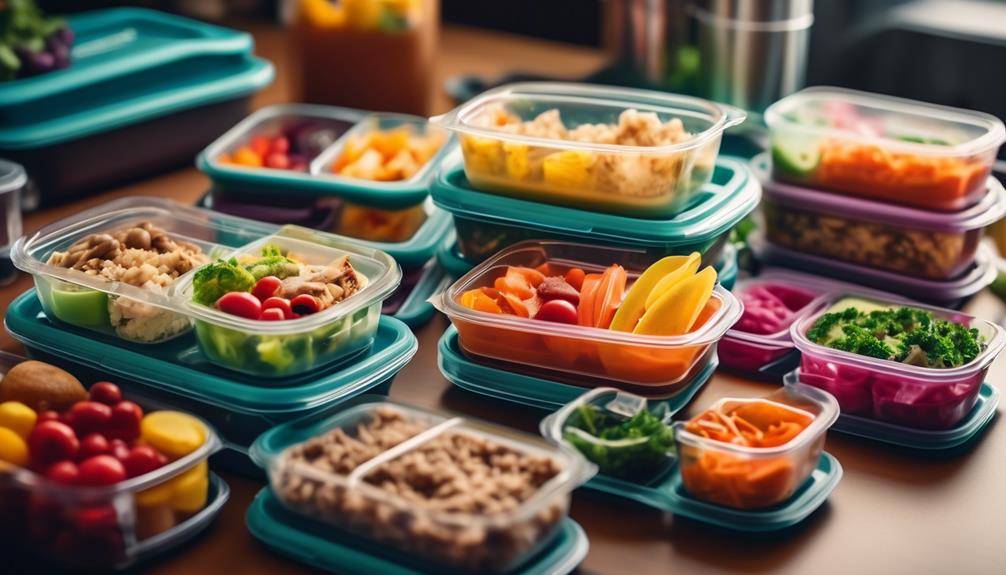How To: Meal Prep Simplified For Fussy Eaters

Are you tired of Meal Prep Simplified For Fussy Eaters, feeling like you’re navigating a never-ending maze of preferences and dislikes? Well, fear not! Meal prep can be as simple as a well-oiled machine, smoothly churning out meals that even the pickiest of eaters will enjoy. In this discussion, we will explore practical strategies and tips to simplify meal prep for fussy eaters, making it a breeze for you and a delight for their taste buds. So, let’s dive in and discover how to create meals that will have even the fussiest of eaters asking for seconds.
Understand Their Preferences
To ensure successful meal prep for fussy eaters, it is crucial to understand their individual food preferences. By involving children in the process and taking the time to understand their preferences, you can create meals that are more likely to be enjoyed and reduce mealtime battles.
Involving children in the meal prep process can help them feel empowered and more willing to try new foods. Start by having conversations with them about their likes and dislikes. Ask open-ended questions to encourage them to express their preferences and give them choices within healthy options. This way, you can tailor meals to their tastes while still providing balanced nutrition.
Observing your child’s eating habits can also provide valuable insights into their preferences. Pay attention to the foods they gravitate towards and those they tend to avoid. Take note of their reactions to different flavors, textures, and colors. This information will help you modify recipes or create new ones that align with their preferences.
Additionally, keep in mind that taste preferences may change over time. Encourage your child to try new foods periodically, even if they have previously rejected them. Their taste buds are constantly evolving, and repeated exposure to different foods can increase their acceptance.
Understanding your child’s preferences is key to successful meal prep for fussy eaters. By involving them in the process and paying attention to their likes and dislikes, you can create meals that are more enjoyable and increase the likelihood of them trying new foods.
Involve Them in the Planning Process
When it comes to meal prep for fussy eaters, involving them in the planning process can make a big difference. Offering menu customization options gives them a sense of control and allows them to choose meals they are more likely to enjoy. Additionally, incorporating fun and interactive meal ideas can make the planning process exciting and engaging for them. By catering to their individual preferences, you can create a meal plan that meets their needs and encourages them to try new foods.
Menu Customization Options
Get your fussy eaters involved in the meal planning process by offering them menu customization options. This allows them to have a say in what they will be eating, increasing the chances that they will actually enjoy their meals. Start by discussing their preferences and dislikes, and then work together to create a menu that includes their favorite ingredients and flavors.
For example, if your child loves pasta but dislikes vegetables, you can incorporate vegetables into the pasta sauce or hide them in a delicious stir-fry. By involving your fussy eaters in the menu customization process, you are empowering them to make choices and giving them a sense of control over their meals. This can lead to a more positive and enjoyable eating experience for everyone involved.
Fun and Interactive Meal Ideas
Consider incorporating fun and interactive meal ideas into your menu planning to involve fussy eaters in the process and make mealtimes more enjoyable for everyone. Fun food games and interactive cooking activities can help create a positive and engaging environment during meal prep. One idea is to turn meal planning into a game by letting fussy eaters choose a theme for each day of the week. For example, they can pick a color and you can plan meals around that color, encouraging them to try new foods within the chosen theme.
Another option is to involve them in the cooking process by letting them build their own pizzas or assemble their own tacos. This not only gives them a sense of control but also introduces them to new ingredients and flavors. By incorporating these interactive meal ideas, you can make mealtimes more enjoyable and encourage fussy eaters to try new foods in a fun and engaging way.
Catering to Individual Preferences
To further cater to individual preferences and involve fussy eaters in the planning process, incorporate their favorite ingredients and dishes into the meal options. A key aspect of understanding preferences is to actively involve fussy eaters in decision making. Ask them what foods they enjoy and what flavors they prefer. This will not only help you create meals that they will actually eat but also make them feel valued and heard.
Encourage them to suggest recipes or provide input on the ingredients they want to include. By involving them in the planning process, you are giving them a sense of ownership over their meals and empowering them to make choices that align with their tastes. This approach can help create a positive mealtime experience and increase the likelihood of them trying new foods.
Focus on Familiar Flavors
When it comes to meal prepping for fussy eaters, it’s important to focus on familiar flavors. Comforting childhood favorites and incorporating familiar ingredients can help make meals more appealing and enjoyable for picky eaters. By sticking to flavors they already know and love, you can increase the chances of them trying and enjoying new dishes.
Comforting Childhood Favorites
Childhood favorites bring comfort and familiarity to meal prep, making it easier to cater to the tastes of even the fussiest eaters. Understanding their preferences is key to adapting recipes that will entice them to eat. By incorporating familiar flavors from their childhood, you can create meals that feel like a warm hug and evoke positive memories.
Think about the dishes they loved as kids, such as mac and cheese, chicken nuggets, or spaghetti and meatballs, and find ways to make healthier versions of these classics. For example, you can use whole wheat pasta, sneak in some vegetables, or bake the chicken nuggets instead of frying them. By recreating their favorite childhood recipes with a healthy twist, you can make meal prep a breeze for even the pickiest eaters.
Incorporating Familiar Ingredients
By incorporating familiar flavors from their childhood favorites, you can easily adapt recipes to cater to the tastes of even the fussiest eaters. Picky eaters often have a limited range of flavors they enjoy, so including ingredients that they are already familiar with can make meal prep less daunting.
Start by identifying the flavors they love the most, whether it’s the sweetness of berries or the savory taste of cheese. Then, adapt familiar recipes by incorporating these flavors in different ways. For example, if they love mac and cheese, try adding vegetables like broccoli or peas to the dish. This not only adds nutrition but also maintains the familiar taste. By adapting familiar recipes, you can create meals that are both comforting and appealing to picky eaters.
Sneak in Hidden Veggies
To ensure your picky eaters are getting their necessary nutrients, cleverly incorporate hidden vegetables into their meals. This can be done through veggie packed snacks and sneaky veggie recipes that will have your little ones unknowingly consuming their daily dose of vitamins and minerals.
Veggie packed snacks are a great way to sneak in hidden vegetables. Instead of reaching for the usual chips or cookies, opt for healthier options like veggie chips or veggie-packed muffins. These snacks are made with real vegetables, such as kale, sweet potatoes, and carrots, which are finely chopped or pureed and incorporated into the snack. Not only do these snacks add an extra serving of vegetables to your child’s diet, but they also provide a boost of fiber and nutrients.
Another way to incorporate hidden vegetables is by using sneaky veggie recipes. For example, you can add finely grated zucchini or carrots to spaghetti sauce or meatballs. The vegetables blend right in with the other ingredients, making it nearly impossible for your picky eaters to detect them. You can also try making vegetable-based sauces for pasta or pizza, such as butternut squash or cauliflower sauce. These sauces not only add flavor but also provide added nutrition.
Experiment With Different Textures
Experiment with different textures to expand your picky eater’s palate and encourage them to try new foods. Adding variety to the textures of your meals can make them more appealing and enjoyable for your fussy eater. By experimenting with different flavors, you can introduce new cooking techniques and create meals that are both tasty and interesting.
One way to vary textures is by incorporating crunchy elements into your dishes. For example, you can add toasted nuts or seeds to salads, stir-fries, or even pasta dishes. The crunchiness adds a new dimension to the meal and can help break the monotony of a plain texture.
Another option is to use different cooking methods to achieve varied textures. Roasting vegetables can give them a crispy exterior while maintaining a soft interior. Grilling or broiling meats can create a charred crust that adds a smoky flavor and a pleasing texture. Steaming or sautéing vegetables can retain their crunchiness while still being cooked through.
You can also experiment with different cooking techniques such as blending or pureeing ingredients to create smooth textures. This can be particularly useful for introducing new flavors to your picky eater. For example, you can blend vegetables into a smooth soup or puree fruits into a creamy smoothie.
Get Creative With Presentation
To make mealtime more appealing for fussy eaters, try getting creative with the presentation of their food. Fun food arrangements, such as turning vegetables into cute animals or arranging fruits into a rainbow, can make the meal more visually appealing and exciting for kids. Colorful plate designs, using different shapes and sizes, can also make the meal more enticing and encourage kids to try new foods.
Fun Food Arrangements
Looking for creative ways to present food to your fussy eaters? Fun food arrangements and creative plating can make meals more appealing and enjoyable for picky eaters. Children are often drawn to visually appealing food, so why not make their meals a work of art? You can create fun food art by arranging fruits and vegetables into different shapes and patterns. For example, you can make a smiley face using sliced fruits or create a colorful vegetable rainbow. By getting creative with presentation, you can make mealtime more exciting and encourage your fussy eaters to try new foods. Remember, presentation is key when it comes to making meals more appealing for picky eaters.
Colorful Plate Designs
Get creative with your presentation by incorporating colorful plate designs to make mealtime more appealing for picky eaters. Here are three engaging food arrangements that can transform an ordinary plate into a visual feast:
- Rainbow Delight: Arrange different colored fruits and vegetables in a vibrant spectrum on the plate. Use red strawberries, orange carrots, yellow bell peppers, green broccoli, and purple grapes to create a colorful and appetizing display.
- Shape Shifter: Cut fruits and vegetables into fun shapes using cookie cutters or sharp knives. Create flower-shaped cucumber slices, star-shaped watermelon pieces, or heart-shaped carrot slices. These playful designs will capture your fussy eater’s attention and make them more willing to try new foods.
- Food Art: Turn mealtime into an art project by arranging ingredients in the shape of animals, cars, or their favorite characters. Use slices of cucumber for eyes, cherry tomatoes for noses, and carrot sticks for whiskers. This creative presentation will add an element of fun and excitement to the meal.
Incorporate Their Favorite Foods
Incorporating their favorite foods into your meal prep can be a creative way to engage fussy eaters and encourage them to try new dishes. By incorporating favorite ingredients, you can accommodate picky eaters while still providing them with a balanced and nutritious meal.
One way to incorporate their favorite foods is to use them as toppings or garnishes. For example, if your child loves cheese, you can sprinkle some grated cheese on top of their vegetables or pasta. This not only adds flavor but also makes the meal more visually appealing. Similarly, if they enjoy fruits, you can add slices of their favorite fruits to a salad or yogurt.
Another strategy is to use their favorite foods as a base for a dish. For instance, if they love pasta, you can make a pasta salad with a variety of colorful vegetables and a light dressing. This way, they get to enjoy their favorite food while also getting a dose of essential nutrients.
You can also try incorporating their favorite flavors into different dishes. If they love the taste of barbecue sauce, you can use it as a marinade for chicken or tofu. If they enjoy the tanginess of lemon, you can squeeze some lemon juice over their fish or vegetables.
Incorporating their favorite foods into your meal prep not only makes the meals more enjoyable for fussy eaters but also gives them a sense of control and familiarity. It encourages them to try new dishes and expand their palate in a fun and engaging way. So, get creative and find ways to incorporate their favorite ingredients into your meal prep!
Offer a Variety of Options
To engage fussy eaters and encourage them to try new dishes, it is important to offer a variety of options in your meal prep. Fussy eaters often have specific preferences and aversions when it comes to food, so providing a range of choices can help accommodate their tastes and increase their willingness to try new things. Here are three ways to offer a variety of options in your meal prep:
- Provide alternative ingredients: Fussy eaters may have certain ingredients they dislike or are allergic to. By offering alternatives, you can ensure everyone has something they can enjoy. For example, if someone dislikes broccoli, you can substitute it with another green vegetable like asparagus or green beans. This allows them to still get the nutritional benefits while catering to their preferences.
- Incorporate different cooking techniques: Fussy eaters may have texture preferences that affect their willingness to try certain foods. By using various cooking techniques, you can create different textures and flavors that may appeal to them. For example, if someone dislikes boiled vegetables, you can try roasting or grilling them instead. This can enhance the taste and texture, making the dish more appealing to them.
- Experiment with different cuisines: Fussy eaters may be more open to trying new dishes if they come from different cuisines. Each cuisine has its own unique flavors and ingredients, which can help expand their palate. For instance, if someone is hesitant about trying seafood, you can introduce them to sushi, which often incorporates seafood in a more approachable way.
Make It Fun With Themed Meals
Make meal prep more enjoyable for fussy eaters by incorporating themed meals into your planning. Themed meal parties can be a fun way to engage fussy eaters and make the dining experience more exciting. By presenting food in a creative way, you can entice their interest and encourage them to try new things.
One idea for a themed meal party is a “Build Your Own Pizza Night.” Provide a variety of toppings such as vegetables, cheeses, and meats, and let your fussy eaters choose what they want to put on their own pizza. This gives them a sense of control and allows them to create a meal that suits their preferences.
Another option is a “Food from Around the World” theme. Introduce your fussy eaters to different cuisines by preparing dishes from various countries. You can serve sushi rolls for a Japanese theme, tacos for a Mexican theme, or stir-fried noodles for a Chinese theme. By exposing them to new flavors in a fun and interactive way, they may be more willing to try new foods.
In addition to themed meal parties, creative food presentation can also make meal prep more enjoyable for fussy eaters. Use cookie cutters to shape sandwiches into fun shapes like stars or animals. Arrange fruits and vegetables in a colorful and appealing manner, such as creating a rainbow fruit skewer or a veggie face on a plate. These visually appealing presentations can make the meal more enticing and encourage fussy eaters to give it a try.
Incorporating themed meals and creative food presentation into your meal prep can help make the dining experience more enjoyable for fussy eaters. By engaging their interest and making food visually appealing, you can encourage them to try new flavors and expand their palate.
Batch Cook Their Preferred Meals
When it comes to meal prepping for fussy eaters, one effective strategy is to batch cook their preferred meals. By customizing their meal options, you can ensure that they are more likely to enjoy and eat the food you prepare. Additionally, planning for variety will help prevent boredom and increase the chances of them trying new foods.
Customize Meal Options
Customize meal options by batch cooking your fussy eater’s preferred meals. This approach allows you to tailor the menu to their specific tastes and preferences, ensuring that they will actually enjoy what they are eating. Here are three reasons why customizing meal options can be beneficial for fussy eaters:
- Personalized Menu: By customizing the meals, you can create a menu that includes their favorite ingredients and flavors. This not only makes the meal more appealing to them but also increases the chances of them trying new foods.
- Increased Variety: Customizing meal options gives you the opportunity to introduce new recipes and ingredients into their diet. This can help expand their palate and encourage them to try new foods in a familiar and comfortable setting.
- Reduced Mealtime Stress: When you batch cook your fussy eater’s preferred meals, you eliminate mealtime battles and reduce stress for both you and your child. Knowing that they have a meal they enjoy waiting for them can make mealtime a more positive experience.
Customizing meal options can be a simple and effective way to meet the dietary needs of your fussy eater while ensuring they are getting the nutrition they need.
Plan for Variety
To ensure a variety of meals for your fussy eater, consider batch cooking their preferred dishes. Planning for variety is essential to keep their meals interesting and to prevent them from getting bored with the same flavors. Incorporating new flavors into their meals can also help expand their taste preferences. Experiment with different spices, herbs, and sauces to add variety and excitement to their meals. You can also try introducing new ingredients gradually to their familiar dishes to expose them to new flavors. By batch cooking their preferred meals and incorporating new flavors, you can provide your fussy eater with a diverse range of meals that will keep them satisfied and excited about their food choices.
Use Dips and Sauces to Enhance Taste
Enhance the taste of meals for fussy eaters by incorporating flavorful dips and sauces. These creative condiments can transform a plain and boring dish into a flavorful and exciting culinary experience. Here are three ways to use dips and sauces to enhance the taste of your meals:
- Flavorful additions: Adding a dip or sauce to your meal can elevate the flavors and make it more enjoyable for fussy eaters. For example, a tangy and spicy salsa can add a burst of flavor to grilled chicken or fish, making it more enticing for those who are picky about their protein. Similarly, a creamy and savory ranch dip can make raw vegetables more appealing, encouraging fussy eaters to indulge in their daily dose of veggies.
- Creative condiments: Get creative with your condiments to add variety and enhance the taste of your meals. Try experimenting with different types of dips and sauces, such as tzatziki, hummus, or pesto, to add unique flavors to your dishes. These condiments can be used as spreads for sandwiches, dressings for salads, or dips for snacks, providing endless possibilities to satisfy even the fussiest eaters.
- Customization options: Dips and sauces offer a great opportunity for customization, allowing fussy eaters to have control over the flavors they enjoy. Provide a variety of dips and sauces on the side, allowing individuals to choose their preferred flavors and adjust the taste according to their preferences. This flexibility can make mealtime more enjoyable for fussy eaters, as they have the freedom to personalize their meals.
Introduce New Foods Gradually
Are you looking for ways to introduce new foods to fussy eaters gradually? Introducing new flavors can be a challenge, especially if your child has food aversions. However, with a gradual approach, you can overcome their resistance and expand their palate.
One strategy is to start by incorporating small amounts of the new food into familiar dishes. For example, if your child enjoys spaghetti, you can add some finely chopped vegetables to the sauce. This way, they will be exposed to the new flavors without feeling overwhelmed. Over time, you can increase the amount of vegetables until they become more comfortable with them.
Another technique is to pair the new food with something they already like. If your child loves macaroni and cheese, you can try adding some pureed butternut squash or cauliflower to the cheese sauce. The familiar taste of the cheese will help mask any unfamiliar flavors, making it easier for them to accept the new food.
It’s important to be patient and understanding during this process. Remember that it may take several attempts before your fussy eater accepts a new food. Encourage them to try a small bite and praise their efforts, even if they don’t like it at first. By creating a positive eating environment and gradually introducing new flavors, you can help your child overcome their food aversions and develop a more varied and nutritious diet.
Consider Portion Sizes and Leftovers
Consider the appropriate portion sizes and how to make use of leftovers when meal prepping for fussy eaters. It is important to take into account their food preferences and manage leftovers effectively. Here are some tips to help you navigate portion sizes and leftovers when preparing meals for fussy eaters:
- Consider their food preferences: Before meal prepping, take some time to understand the specific food preferences of the fussy eater. This will help you plan meals that they are more likely to enjoy and finish. If they have specific dislikes or aversions, avoid including those ingredients in their meals. By considering their preferences, you can ensure that the portion sizes you prepare are suitable for their appetite.
- Manage leftovers smartly: Leftovers can be a great way to save time and reduce food waste. However, for fussy eaters, leftovers may not always be appealing. To make use of leftovers, consider repurposing them into new dishes. For example, leftover chicken can be used in sandwiches or salads, and cooked vegetables can be added to soups or omelettes. By being creative and utilizing leftovers in different ways, you can provide variety in their meals and prevent them from getting bored.
- Control portion sizes: Fussy eaters may have smaller appetites or specific preferences for certain foods. It is important to adjust portion sizes accordingly. Start with smaller portions and observe their appetite. If they consistently finish their meals, gradually increase the portion size to meet their nutritional needs. However, if they frequently leave a lot of food uneaten, consider reducing the portion sizes to avoid waste and ensure they are not overwhelmed.
Adapt Recipes to Suit Their Taste Buds
To cater to the taste buds of fussy eaters, adapt recipes by incorporating familiar flavors and textures they enjoy. Dealing with picky eaters can be challenging, but with the right adaptation strategies, meal prep can become a lot easier and more enjoyable for everyone involved.
One effective strategy is to start with a base recipe that the fussy eater already likes. For example, if they enjoy pasta dishes, you can adapt a recipe by using their preferred type of pasta and incorporating ingredients they enjoy, such as cheese or tomato sauce. By starting with a familiar base, you can gradually introduce new flavors and ingredients to expand their palate.
Another strategy is to make small modifications to the recipe to suit their taste buds. For example, if they don’t like vegetables, you can try pureeing them and adding them to sauces or soups. This way, they still get the nutritional benefits without the overwhelming taste or texture.
It’s also important to consider the presentation of the meal. Fussy eaters are often more likely to try a dish if it looks appealing. You can make the meal visually appealing by arranging the food in an attractive way or adding garnishes that they enjoy.
Incorporating familiar flavors and textures in recipes is an essential part of adapting meals for fussy eaters. By using these adaptation strategies, you can create meals that cater to their taste buds while also introducing new flavors and ingredients. Remember to be patient and persistent, as it may take time for them to develop a liking for new foods.
Meal Prep Simplified For Fussy Eaters; Frequently Asked Questions
How Do I Get My Fussy Eater to Try New Foods?
To get your fussy eater to try new foods, involve them in meal preparation. Introduce new foods through fun activities like creating colorful food art or having a taste test challenge.
What Are Some Creative Ways to Present Meals to Make Them More Appealing to Fussy Eaters?
To make meals more appealing to fussy eaters, try creative plating and fun food art. These techniques can make food visually interesting and encourage kids to try new things.
How Can I Ensure My Fussy Eater Is Getting Enough Nutrients if They Only Want to Eat a Limited Variety of Foods?
To ensure your fussy eater gets enough nutrients with a limited variety of foods, try incorporating nutrient-rich alternatives like smoothies or purees. Balance their nutritional needs by offering a variety of foods from different food groups.
What Are Some Tips for Adapting Recipes to Suit My Fussy Eater’s Taste Buds Without Compromising on Flavor?
To adapt recipes for your fussy eater’s taste buds without compromising flavor, here are some meal prep hacks: offer familiar foods in new ways, involve them in cooking, sneak in nutritious ingredients, and be patient.
How Can I Encourage My Fussy Eater to Eat Leftovers Without It Feeling Like They’re Eating the Same Meal Over and Over Again?
Encourage variety in leftovers by getting creative with meal planning. Try repurposing leftovers into new dishes, like turning chicken into tacos or adding veggies to pasta. This way, it won’t feel like eating the same meal over and over again.
Conclusion
In conclusion, simplifying meal prep for fussy eaters can be achieved by understanding their preferences, involving them in the planning process, focusing on familiar flavors, sneaking in hidden veggies, experimenting with different textures, using dips and sauces to enhance taste, introducing new foods gradually, considering portion sizes and leftovers, and adapting recipes to suit their taste buds. By following these strategies, it is possible to create meals that are both nutritious and appealing to even the pickiest eaters.








